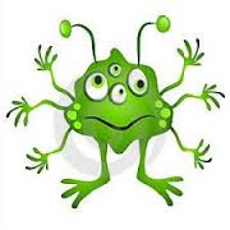TYPES OF NUTRIENTS
A healthy, balanced diet consists of the right amount of the nutrients your body needs to function properly.
Your body is a machine and food is fuel. The six types of nutrients are:
1. Water
2. Carbohydrates
3. Protein
4. Fats
5. Vitamins
6. Minerals
Water: Yes, water is a nutrient. It is the most important nutrient. In fact, your body is mostly water. Water carries nutrients to the cells in your body.
Protein: Proteins are nutrients that are essential to the building, maintenance, and repair of body tissuesuch as the skin, the internal organs, and muscle. They are also the major components of our immune system and hormones.
Carbohydrates: Carbohydrates provide fuel for the body in the form of glucose. Glucose is a sugar that is the primary source of energy for all of the body's cells. Adults should get about 45% of their calories from carbohydrates.
Fats: Fat is made up of compounds called fatty acids or lipids. Depending on their chemical structure, these fatty acids are called monounsaturated, polyunsaturated, saturated, or trans fats. Trans fats and saturated fats are the unhealthiest fats to eat.
Vitamins: Vitamins help with chemical reactions in the body. In general, vitamins must come from the diet; the body doesn't make them. There are 13 vitamins essential to the body. They are divided into two categories: water-soluble (vitamin C and all the B vitamins) and fat- soluble (vitamins A, D, E, and K).
Minerals: Minerals, like vitamins, must come from the diet; the body doesn't make them. Many minerals are vital to the proper function of the body and must be taken in relatively large amounts (such as calcium, potassium, and iron). Others, like trace minerals (zinc, selenium, and copper), are only needed in small amounts to maintain good health.
Vocabulary
|
Specific vocabulary
|
Consist of: consistir en (algo), basado en (algo)
|
Cells: células
|
Properly: correctamente
|
Body tissue: tejído corporal. Un tejido se refiere a un grupo de células similares, y que por lo tanto tienen una misma función en el cuerpo. La unión de tejidos forma los diferentes órganos.
|
Meets: satisface
|
Immune system: Sistema inmunológico. Este sistema es la defensa natural del cuerpo contra las infecciones.
|
Provide: proporcionar
|
Hormones: Hormónas. Las hormónas son los mensajeros químicos del cuerpo, se encargan de varias funciones y circulan a través de la sangre.
|
Should get: debe obtener
|
Chemical structure: estructura química (de una sustancia), es decir, su composición química, cómo se enlazan sus átomos e iones.
|
Made up of: compuesto de (algo)
|
Monounsaturated, polyunsaturated, saturated, or trans fats: son tipos de grasas
|
Compounds: compuestos
|
13 vitamins essential: se refiere a que es importantísimo, que comamos alimentos que contengan una o varias de estas vitaminas porque nuestro cuerpo no las fabrica.
|







